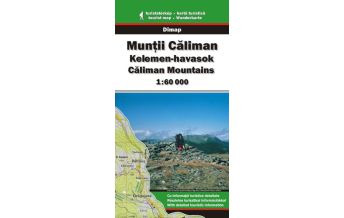Wanderkarte MN-09, Ceahlău 1:50.000/1:25.000
Ostkarpaten

Tags
Ceahlau Massif is the most famous and most impressive massif in the central part of the Eastern Carpathians, one of the few Carpathian landscapes still retaining some of their unspoiled nature. Ceahlau is the loftiest massif in the Eastern Carpathians, as it is located in the heart of this mountain range, with coordinates 47°N 26°E.
Surrounded by Bistricioara valley to the north, Bicaz valley to the south, Bistrita valley to the east and Bistra, Pinticul and Jidanul valleys to the west, Ceahlau consists of a system of radial ridges, with elevations ranging from 1000 to 1300 m that converge to the two highest peaks: Ocolasul Mare Peak (1907 m) and Toaca Peak (1904 m).
Ceahlau National Park was established initially as a protected area by the Order of the Council of Ministers no. 1625 in 1955. The current boundaries, marked with a red square in a white frame, were given by Government Resolution no. 230 of 2003 on "The delimitation of biosphere reserves, national and natural parks and the establishment of their administration". Today, Ceahlau National Park spans an area of 7742.5 ha.
The map of Ceahlau Massif (MN09) is the 9th map of the new Muntii Nostri collection.
The map was edited using the latest mapping techniques and it was printed on moisture resistant paper. It is easy to read and simple to use due to the mapping styles, specific to Schubert & Franzke company, and as a result of practical information structuring. It is handy and everything is exactly where it should be. The map is useful for both hiking enthusiasts and professionals.
Higher area appears on a more detailed scale in 1:25.000.
All the trails have been recorded in the field using a GPS. They are described in detail in both Romanian and English. Each trail has a technical box containing with necessary information. The map also contains the UTM grid, a projected coordinate metric system useful in the quick measurement of distances on the map.
Weight:
50 g
Publisher:
Series:
Scale:
1:50.000
Product Type:
Maps
Language:
English, Romanian
EAN:
5948490930597
Year of publication:
2022
Write Your Own Review
No manufacturer information and safety instructions available yet.







